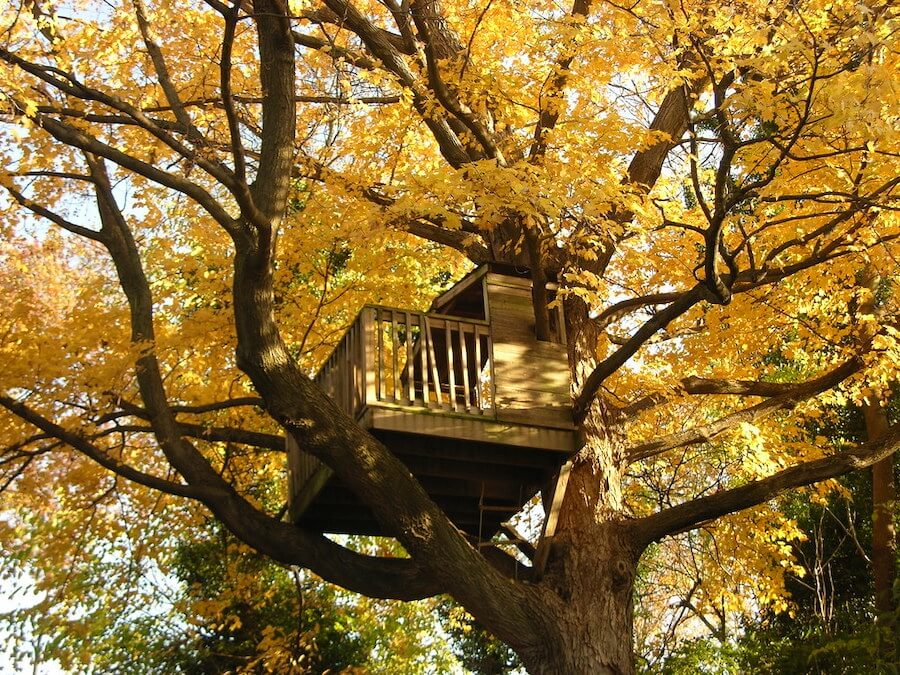A treehouse is a terrific way to return to nature. It gives you the best experience you ever find in a shelter, but building it properly is never an easy task.
If you intend to create such a beautiful house, start by answering the question: How big does a tree need to be for a treehouse? Let us help you with that.
Table of Contents
How Big Does A Tree Need To Be For A Treehouse?
For a typical treehouse, the tree should be about 8 to 12 inches in diameter.
The tree size will differ depending on how big you want your treehouse to be and where you intend to locate it.
If you plan to build your house on just one tree, choose the one with a thicker diameter. Such a thick tree is necessary if your house gets heavier than expected.
Think about the weight of your treehouse while selecting its tree. It depends on the kind of wood you use to build it and the features you want to add.
How to choose a big tree?
A big tree must be stable to build a treehouse on. But how do you define a “big tree”? We have mentioned the diameter above, so this section focuses on three other factors.
- Limbs
Tree limbs randomly develop in various sizes, forms, angles, and widths. The secret to constructing a sturdy treehouse is picking a tree with limbs at 90 degrees.
- Branches
Your treehouse gets most of its support from the branches. Instead of choosing a tree with many more supporters, choose one with fewer yet stronger ones.
The variety of trees will significantly impact how robust the branches are.
- Height
This factor depends on who you build the treehouse for and how you want to use it. If it’s for kids, choose a tree that is ten feet tall or shorter to avoid falls and injuries.
How to tell if a tree is strong enough?
The most critical factor to check for is the tree’s condition. Whatever type of tree you pick won’t be worth anything if the tree is unhealthy.
You can hire a qualified arborist to evaluate the trees in your backyard. Yet, you should still be able to distinguish between healthy and unhealthy trees.
Some apparent signs of weak trees are discolored leaves and dead branches. They may also leak liquid from their barks.
Your tree can’t sustain the treehouse if you see any signs of illness or death on it. Also, people can’t climb into the house because of the weak foundation.
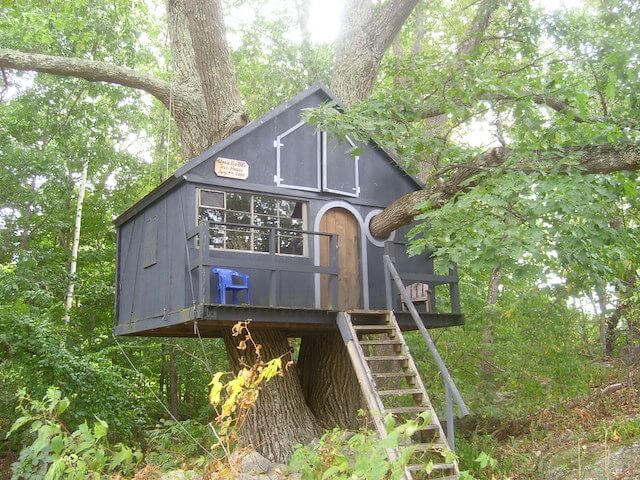
Best Trees To Build A Treehouse
Some tree species are more advantageous for your treehouse than others. Here are our top recommendations.
Douglas Firs
Despite being a kind of softwood, Douglas fir is a strong and stable solution for a treehouse’s base.
In some regions, the Douglas fir may reach heights of up to 250 feet, producing extending branches that are tough and supportive for construction.
Furthermore, this tree’s bark is thick, making it simpler to attach the support bolts for the framework.
Due to the size and diameter of the trunks of these trees, which generally grow close to one another, you will have more choices for designing your treehouse.
Maple Trees
Most maple tree species fall into two categories: hard or soft wood, making them ideal for treehouse construction.
Although some kinds of maple trees only achieve a height of 33 feet when fully mature, the maximum size of most species is around 150 feet.
Avoid the shrubby variations of Maple if you’re planning to build a treehouse.
Their thin trunks and low height (ten feet or shorter) might pose challenges for the construction.
Since the tree’s wood is so thick, it can hold a heavier load when you position the support beams correctly.
It implies that your treehouse may be bigger while still enabling you to welcome more visitors.
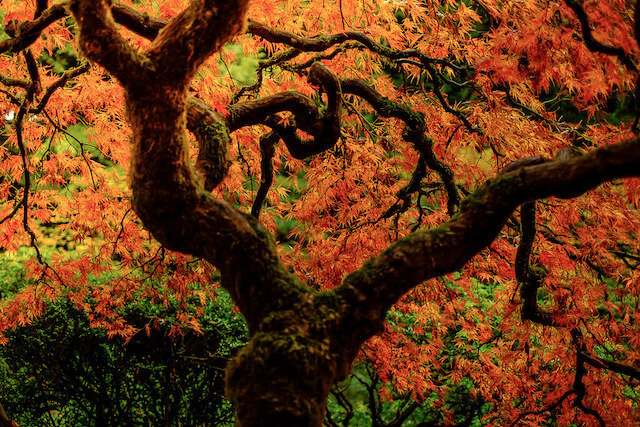
Pawpaw Trees
Pawpaw is America’s best-kept secret fruit. You may also have heard about it as the biggest tree that grows in North America and yields edible fruit.
If you have many of them flourishing on your property, most species may grow up to 25 feet high. They offer you a soft hardwood ideal for constructing treehouses.
The wood from pawpaw trees catches your eyes quickly because it is finely grained and feels somewhat spongy.
Besides, it is more durable than many softwoods like poplar or pine due to its median density.
Hickory Trees
Hickory trees fall under solid hardwood groups because of their thick structure, which benefits a sturdy foundation.
The trees offer gorgeous, high-branching canopies. Furthermore, they can still provide a lot of shade with little maintenance.
All Hickory species have a spread of about 40 feet when fully mature, and they may reach a height of up to 80 feet.
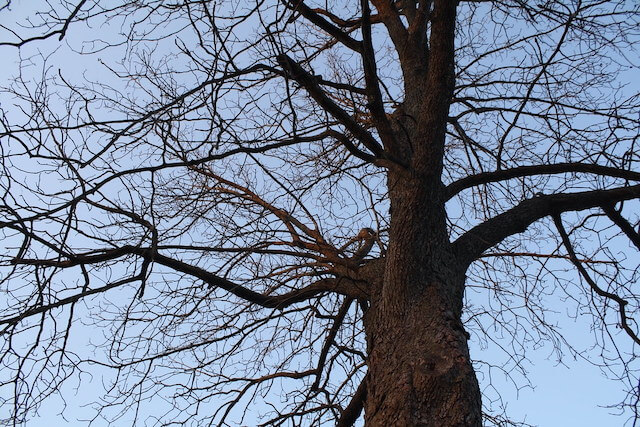
Acacia Trees
Most species in this category have long thorns that shield the main trunk.
However, they can be challenging to maneuver around. If you can address these limitations, you will have one of the best trees at withstanding fires.
The tree’s slightly limited lifetime is the sole disadvantage. These trees may grow quickly, even though most have a maximum lifespan of 30 years.
Boxelder Trees
You need to wait until the tree matures fully to use it for your treehouse.
The tissue of this species often develops fast, making it brittle and feeble. It is challenging to build structural support until it’s at least 30 feet tall.
Remember to choose male Boxelder trees as the foundation of your treehouse.
The female counterparts will draw swarms of boxelder bugs during the summer and fall.
Besides, to build the construction securely and with a sturdy base, you will also require multiple Boxelder trees.
Oak Trees
Since each variant of Oak is solid hardwood, you can expect exceptional support.
Even yet, you can realize that all it takes to build a gorgeous house to use for years is a small number of powerful alternatives.
The oak tree’s resilience makes it an excellent choice for construction since its thick trunks offer almost unbeatable stability.
What’s more, the bark and leaves of this species contain a lot of tannic acids.
After building your treehouse, you will experience fewer problems with fungal growth and bug infestations.
Normally, oak trees grow up to 80 feet in height. This size provides a remarkable amount of shade without compromising the view your treehouse can give.
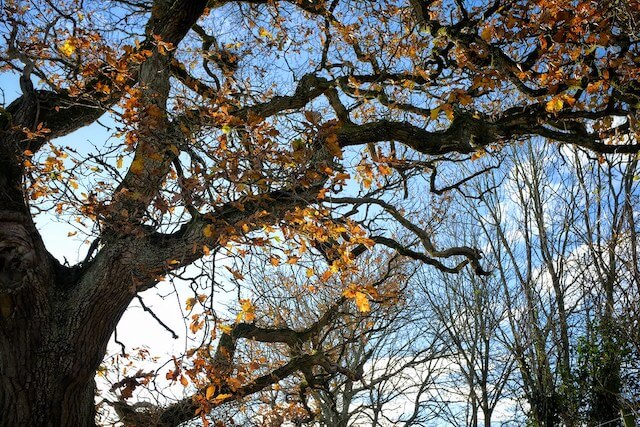
Trees To Avoid When Building A Treehouse
When choosing a tree for your treehouse, avoid these ones:
- Soft soil: Trees that grow on soft soil can’t handle the structure because they have weak root systems.
- Steep slopes: The slopes affect a tree’s root system.
- Rocky areas: Roots can’t grow deep in these places, making the tree less stable.
- Insect or fungal infestations: Infestations can spread. Hence, even though your targeted tree looks healthy, it will get infected by the nearby trees with infestation signs.
Crooked trunks: Such trunks can’t be solid and stable enough to bear too much pressure.
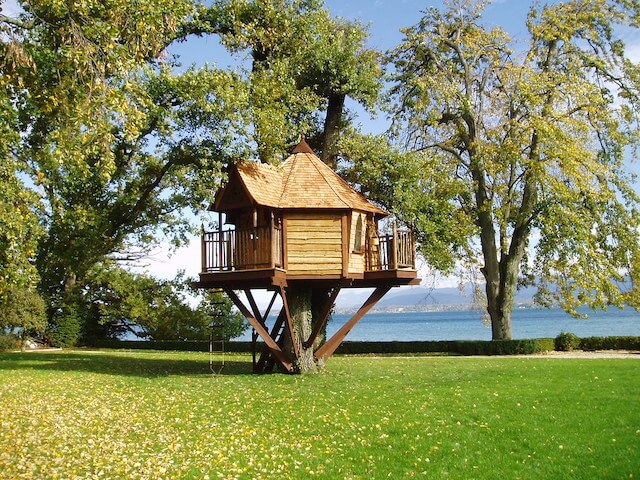
Conclusion
A tree with a diameter of 8 to 12 inches can be big enough to build your treehouse. Don’t forget to consider its branches, limbs, root system, and height.
Hopefully, we have given you all you need to know. If you have any questions, please get in touch with us. We are so eager to help.
Thank you for reading!

